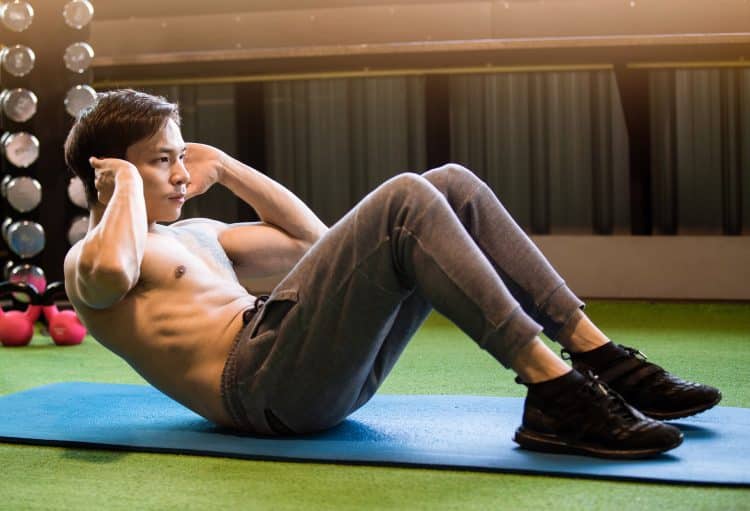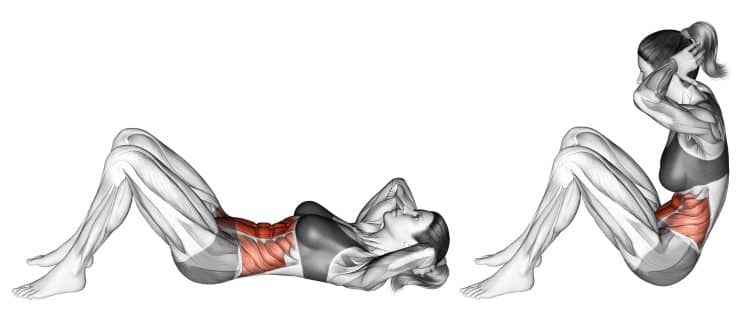The sit-up is one of the most popular exercises. It is taught in school PT classes, done at home, and is a part of the most complex metabolic conditioning workouts. This versatile exercise works your midsection and can help build a shredded six-pack. Sit-ups can also improve your posture, core strength, and balance.
Most people have a love-hate relationship with sit-ups. They love the results but hate doing the exercise. Although sit-ups look easy, they will have you begging for mercy halfway through a set. They are especially difficult for beginners that lack abdominal strength and endurance. Furthermore, many exercisers find sit-ups boring.
That said, thanks to their effectiveness and results, sit-ups are a part of most training regimens, and this doesn’t appear to be changing any time soon.
Notably, sit-ups are often confused with their cousin — crunches. Both these exercises look similar to an untrained eye, and ‘sit-ups’ and ‘crunches’ are often used interchangeably. However, these exercises have significant differences.
The biggest difference between the two exercises is their range of motion. The crunch is roughly a quarter of the sit-up’s range of motion (ROM). While performing the crunch, your lower back is always in contact with the floor; in fact, your upper back, too, barely leaves the floor. However, as the name implies, the sit-up involves sitting upright at the top of the range of motion.
The sizeable difference in the ROM leads to the isolation of your abdominal muscles while performing the crunch. On the other hand, sit-ups stimulate multiple muscle groups, including the abs, hip flexors, hips, and lower back.
Level Up Your Fitness: Join our 💪 strong community in Fitness Volt Newsletter. Get daily inspiration, expert-backed workouts, nutrition tips, the latest in strength sports, and the support you need to reach your goals. Subscribe for free!
In this article, I take you over the fundamentals of the sit-up, the muscles worked during this exercise, its benefits, proper form, the most common mistakes, and the best variations and alternatives.
What is a Sit-Up?
A shredded midriff and a six-pack are considered the epitome of fitness, and the sit-ups help you achieve just this. This exercise involves contracting your abs with every rep, which helps you develop a chiseled midsection. The sit-up is an isolation exercise that trains your abdominal muscles.
To perform a sit-up, lie supine and place your feet flat on the floor. While holding your hands at the side of your head, lift your torso off the floor by contracting your abs. Your upper body should be almost parallel to the floor at the top of the motion — anything between 12 and 1 ‘o clock is acceptable.
Since performing the sit-up requires no equipment, you can do it anywhere. As you gain more experience, you can make the exercise more challenging by incorporating additional resistance using a weighted vest or holding a dumbbell, weight plate, or kettlebell in front of your chest.
The sit-up primarily works the upper and middle abs. However, you can achieve better lower ab stimulation by performing this exercise on a decline bench. Conversely, beginners can perform this exercise on a stability ball, as it provides a little assistance at the bottom of the movement.
Muscles Worked During a Sit-Up
The sit-up works the following muscles:
Abs
Sit-ups work the rectus and transverse abdominis. The rectus abdominis is the long vertical muscle that runs down the front of your abdomen. It is also known as the six-pack. On the other hand, the transverse abdominis muscle wraps around the abdomen and provides stability and support to the spine and internal organs. The transverse abdominis plays a crucial role in core stability while performing sit-ups and other exercises.
Obliques
Sit-ups work the internal and external obliques. The external obliques are the fish-gill-like muscles at the side of the rectus abdominis and help with trunk rotation and bending movements. The internal obliques lie under the external obliques and also assist with trunk rotation and bending.
Hip Flexors
Hip flexors run along the front of your upper thigh. They are responsible for flexing the hip joint. Hip flexors engage during the sit-up’s concentric (upward) motion to lift the torso toward your thighs.
Hips
Your hips provide stability during the sit-ups. The hip joint flexion also allows you to move from a lying to a seated position. Strong hips will also help prevent lower back strain while performing the exercise.
Lower Back
Your lower back, especially the erector spinae, plays a crucial role by providing stability and maintaining proper spinal alignment while performing sit-ups. It helps you avoid rounding your lower back during the concentric motion.
Benefits of Sit-Ups
Here are the advantages of adding sit-ups to your training regimen:
Improved Core Strength
Performing sit-ups helps you build a stronger core, the benefits of which carry over to compound exercises. Furthermore, it improves your performance in daily activities, which helps you get done more quickly and effectively.
Boost in Athletic Performance
A strong core can help improve your athletic performance. Irrespective of your sport, sit-ups can improve your posture, stability, and form, which can boost your overall performance and results. It will also significantly delay the onset of fatigue.
Increase in Muscle Mass
Sit-ups can help build muscle mass and strength in the abdominal and hip muscles. This exercise can also be a valuable indicator of muscle loss. A 2016 study found that older women who could perform sit-ups were less likely to lose muscle mass with age. [1]
Improved Balance and Stability
Sit-ups help build a strong core, which improves your balance and stability. It can improve your performance in daily activities and other exercises. A stronger core can also help prevent falls in older adults.
Better Posture
Building a strong core helps keep your hips, spine, and shoulders in alignment, which helps promotes a better posture. Folks that have a desk job or spend the majority of their days sitting should make sit-ups a constant in their training regimen.
No Equipment
Sit-ups are a bodyweight exercise that you can do anywhere at your convenience. Plus, you can program this versatile exercise into most training regimens and use additional resistance for better results.
How To Do Sit-Up
This is how to perform the sit-up with the correct form:
Steps:
- Lie supine on the floor. Bend your knees and plant your feet on the ground.
- Hold your hands next to your ear.
- Raise your torso off the floor by contracting your abs. Exhale sharply during the concentric movement.
- Your torso should be perpendicular to the floor at the top of the movement.
- Contract your abs as hard as possible.
- Inhale as you slowly lower your torso to the floor.
- Repeat for recommended reps.
Sit-Up Tips:
- Your head should remain neutral throughout the range of motion. Bending your head during the concentric movement puts unnecessary strain on your neck.
- Avoid interlacing your fingers behind your head as it increases your odds of bending your neck during the upward motion. Crossing your arms in front of your chest is a better alternative if you don’t prefer holding your hands next to your ears.
- Exhale and contract your abs during the upward motion.
- Keep your back straight throughout the range of motion. Rounding your back can strain your lower back.
- Use an elevated surface to anchor your feet. This will help keep your feet planted on the floor and allow you to establish a better mind-muscle connection.
- It is common for beginners to experience ab cramps while doing sit-ups. Stop the exercise if you experience cramps and stretch out your abs.
In This Exercise:
- Target Muscle Group: Abs
- Type: Strength
- Mechanics: Isolation
- Equipment: Bodyweight
- Difficulty: Beginner
- Best Rep Range: 8-12
Common Mistakes While Performing Sit-Up
These are some of the most common sit-up mistakes that you must avoid to maximize results and lower the risk of injury:
Level Up Your Fitness: Join our 💪 strong community in Fitness Volt Newsletter. Get daily inspiration, expert-backed workouts, nutrition tips, the latest in strength sports, and the support you need to reach your goals. Subscribe for free!
Using a Limited Range of Motion
Many people leave gains on the table by following an incorrect form and a restricted range of motion. Your back should be on the floor at the bottom, and it should be perpendicular to the floor at the top.
Using Momentum
Exercisers try to make this exercise easier by using momentum. Avoid throwing your arms toward your legs to lift your torso off the floor. Driving through your neck during the concentric motion can cause neck sprains.
Neck Strain
Sit-ups are a demanding exercise. You must keep your head, neck, and torso in a straight line throughout the exercise for optimal ab stimulation. Folks that interlace their fingers behind their necks or throw their heads forward during the concentric motion increase their odds of injury during the exercise.
Rounding Your Back at the Top
Think of your torso as a hardboard while doing sit-ups; it should move in a straight line. Rounding your back at the top of the motion causes unnecessary lower back strain. It will also hamper your form during the eccentric (lowering) motion.
Improper Breathing
Many people make the mistake of holding their breath while performing crunches. Breathing correctly while performing crunches can help amplify your results. Exhale sharply during the concentric motion and inhale during the eccentric motion.
Not Adding Variety To Your Training Regimen
Although crunches are a great exercise to build a shredded midriff, your training program must include exercises that train your torso from different angles for overall development. It will ensure you build a bulletproof midsection. This point is a perfect segue into…
Variations and Alternatives of Sit-Ups
Add the following sit-up variations and alternatives to your training regimen to build a shredded midsection:
Weighted Sit-Up
Weighted sit-ups are for advanced athletes. It involves holding additional resistance, such as a dumbbell, kettlebell, or weight plate, in front of your chest. The exercise form for this variation will remain the same as the conventional sit-up.
Pro Tip: Use an appropriate weight that allows you to keep your head and torso in a straight line throughout the range of motion. Using a weight that is too heavy can cause you to bend your head forward.
Stability Ball Sit-Up
Stability ball sit-ups are an excellent exercise for beginners as the exercise ball acts as a support at the bottom of the movement and delivers a pop that pushes you into the next rep.
Steps:
- Sit upright on an exercise ball and plant your feet flat on the floor.
- Hold your hands at your ear level and slide forward so your lower and middle back are on the exercise ball. Your shoulders should be hanging off the ball.
- Exhale and contract your abs to lift your torso toward the ceiling.
- Your torso should be perpendicular to the floor at the top.
- Slowly return to the start position.
- Rinse and repeat.
Pro Tip: Some trainers go down too fast during the eccentric motion to use the bounce from the ball to complete the next rep. However, this reduces the effectiveness of the exercise and increases your risk of lower back injury.
Reverse Crunch
Sit-ups and crunches work the upper and middle abs. On the other hand, reverse crunches focus on your lower abs. During a sit-up, your lower body remains steady while your upper body moves. The reverse is true for the reverse crunch.
Steps:
- Lie with your back on the floor. Your body should be in a straight line at the starting position.
- Place your hands under your hips for leverage.
- Lift your feet off the floor so your heels are a few inches off the ground.
- Pull your quads to your chest while bending your knees.
- Your hips should be off the floor at the top.
- Slowly return to the start position.
- Repeat for recommended reps.
Pro Tip: Make this exercise more challenging by performing this exercise on an elevated platform, such as a flat bench. Let your feet touch the floor at the bottom of the movement for better abdominal stimulation.
Check out our complete reverse crunch guide!
V-Up
The V-up is a great exercise to build core strength, balance, stability, and coordination. This exercise targets your entire midsection, including your upper, middle, and lower abs.
Steps:
- Lie flat on your back on the floor.
- Extend your arms toward the ceiling so they are perpendicular to the floor. Simultaneously, raise your legs off the floor.
- In a single motion, lift your legs toward the ceiling and bring your hands toward your feet.
- Your body should resemble a “V” at the static contraction point at the top.
- Slowly lower to the starting position.
- Repeat for recommended reps.
Pro Tip: Experienced lifters can make this exercise more challenging by wearing ankle weights and holding a pair of dumbbells.
Check out our complete V-up guide!
Crunch
The crunch is the easier version of the sit-up and roughly involves a quarter of the sit-up’s range of motion. This exercise is a better option for people trying to maintain constant tension in their upper abs or undergoing rehabilitation.
Steps:
- Lie supine on the floor. Bend your knees and plant your feet flat on the ground.
- Hold your hands next to your ears.
- Contract your core, and exhale as you lift only your head and shoulder blades off the ground.
- Slowly lower to the starting position.
- Repeat for reps.
Pro Tip: Like with sit-ups, you can perform crunches while holding onto weights or on a decline for greater abdominal stimulation.
Check out our complete crunch guide!
Bicycle Crunch
The bicycle crunch is one of the few ab exercises that simultaneously work your lower and upper body. This ab exercise is incredibly effective at working your lower and upper abs and obliques.
Steps:
- Lie flat on the floor while facing the ceiling.
- Hold your hands next to your ears and lift your legs off the floor.
- Exhale as you bring your right knee to your chest while driving your left elbow to the knee.
- Return to the starting position.
- Repeat on the other side.
- Alternate between sides for the recommended reps.
Pro Tip: Focus on your breathing to make the most of this exercise. Breathe out during the concentric motion and breathe in during the eccentric motion.
Check out our complete bicycle crunch guide!
Wrapping Up
The sit-up is a versatile beginner-friendly exercise that will help improve your core strength, balance, stability, and posture, boost your athletic performance and muscle mass, and can be done anywhere at your convenience.
Although sit-ups are a great exercise to work your midsection, your ab training routine should include a variety of movements to ensure overall development. Remember, building a six-pack requires patience, dedication, commitment, and a low body fat percentage. Nail each aspect of your training, diet, and recovery regimen, and your abs will rival those of Greek statues. Best of luck!
Related: Crunch and Sit-Up Alternatives
References
- Abe T, Yaginuma Y, Fujita E, Thiebaud RS, Kawanishi M, Akamine T. Associations of sit-up ability with sarcopenia classification measures in Japanese older women. Interv Med Appl Sci. 2016 Dec;8(4):152-157. doi: 10.1556/1646.8.2016.4.7. PMID: 28180004; PMCID: PMC5283773.
Interested in measuring your progress? Check out our strength standards for Sit Ups, Reverse Crunches, Bicycle Crunch, and more.













